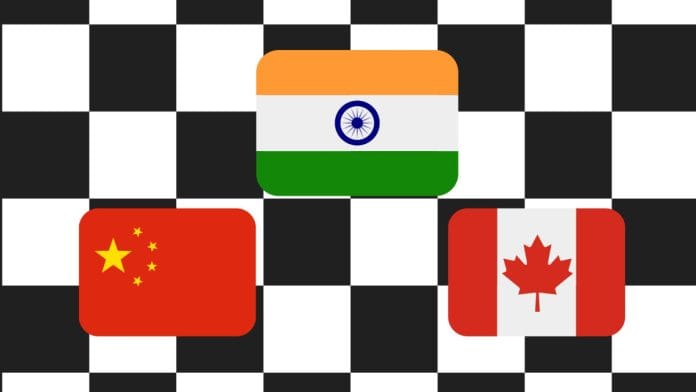Thank you dear subscribers, we are overwhelmed with your response.
Your Turn is a unique section from ThePrint featuring points of view from its subscribers. If you are a subscriber, have a point of view, please send it to us. If not, do subscribe here: https://englishdev.theprint.in/subscribe/
The current global environment, where west led by USA is planning strategic moves to check the rise of China’s influence resembles with a classic chessboard. Each geopolitical move has consequences and recent events vividly depicts the complexities involved in this grand chess game.
Canada and India are the key players in this grand game. But things took unexpected turn on Sept 18th when allegations were put forward by Justin Trudeau led Canadian government regarding the killing of Canadian citizen Hardeep Singh Nijjar. It has brought out the cracks in the diplomatic relations between India and Canada in particular and anti-china camp in general. It becomes significant to draw parallels between India and China with respect to Canada in order to understand whether this awkwardness could have been avoided by simply weighing the positives and looking at the bigger picture.
Canada-China conundrum: A closer reading of bilateral ties reflects deep-rooted cultural and ideological differences between the two sovereigns. The famous tit for tat arrest case of Ms. Weng Wanzhou and Michaels (Spavor & Kovrig) recently got resolved post their respective releases, is enough to show the diplomatic tensions run between both the nations. The Canadian government’s allegations against China are multifaceted. Accusations range from interference in the 2019 federal elections to the operation of illegal ‘police stations’ on Canadian soil by China. This transgresses the political sovereignty lines of Ottawa along with undermining of its democratic principles. Beyond this meddling, China’s state is also accused of harassing Canadian citizens and activists living in Canada fighting for justice in Tibet and Hong Kong. The free trade agreement between both the nations could not be capitalised due Beijing’s not conformity with labour rights clause mentioned in the document.
Canada in its Indo pacific strategy document 2022 mentioned China as disruptor, also inked the plight of Uighur Muslims in Xinjiang. Rallying allegations underscores a clash of values and threats faced by Uyghurs in Canada and their family members in China. Canada is increasing its military exercises with South Korea and Japan, post militarisation of South China Sea by Beijing. Ottawa is committed to its liberal values and realises that China’s aggressive rise is not in its favour plus does not align with its fundamental democratic principles.
India and Canada: The diplomatic channels could have been explored behind the curtains to address the issue without causing a significant rift. However, the matter unfolded on the global stage leading to a rapid deterioration of diplomatic ties. Deep understanding of the matter goes back in 1980s era, India through diplomatic channels flagged the conspiracies designed by separatists on Canadian soil against its Unity, which became a bone of contention for both the countries multiple times. India’s swift and assertive response symbolises the nation’s commitment to safeguarding its national interests. However, New Delhi being true to its diplomatic nature, has also expressed willingness to collaborate with Canadian authorities if provided with credible evidences.
Despite this recent setback, India and Canada have shared warm bilateral relations for decades, with occasional hiccups that, historically, have been navigated diplomatically. Canada, in its Indo-Pacific Strategy Document of 2022, acknowledges India as a rising economy, the world’s largest democracy, and a nation with shared values of pluralism and a rules-based order.
The Indo-Pacific Strategy also highlights the increasing people-to-people contacts and commercial engagements between the two nations. Both countries were optimistic about capitalizing on gains through the early progress trade agreement (EPTA). However, the recent diplomatic spat has cast a shadow over these hopeful prospects.
Conclusion: The recent diplomatic tensions between India and Canada present an uncomfortable moment for the global diplomatic community, particularly the Five Eyes alliance and the broader Western bloc. While Western diplomats have refrained from using harsh language against India, the incident underscores the need for the USA and its allies to keep their diplomatic house in order.
In the current geopolitical chessboard, where Chinese aggression is a focal point, India plays a crucial role as a strategic Queen against the rising influence of the Chinese king. However, Canada’s recent move has blocked the Queen’s movements for a while and disrupted the coordinated efforts of the West, introducing a distraction in the delicate balance of the international realm. The international awkwardness could have been avoided by taking the high road of diplomatic maturity.
These pieces are being published as they have been received – they have not been edited/fact-checked by ThePrint.


